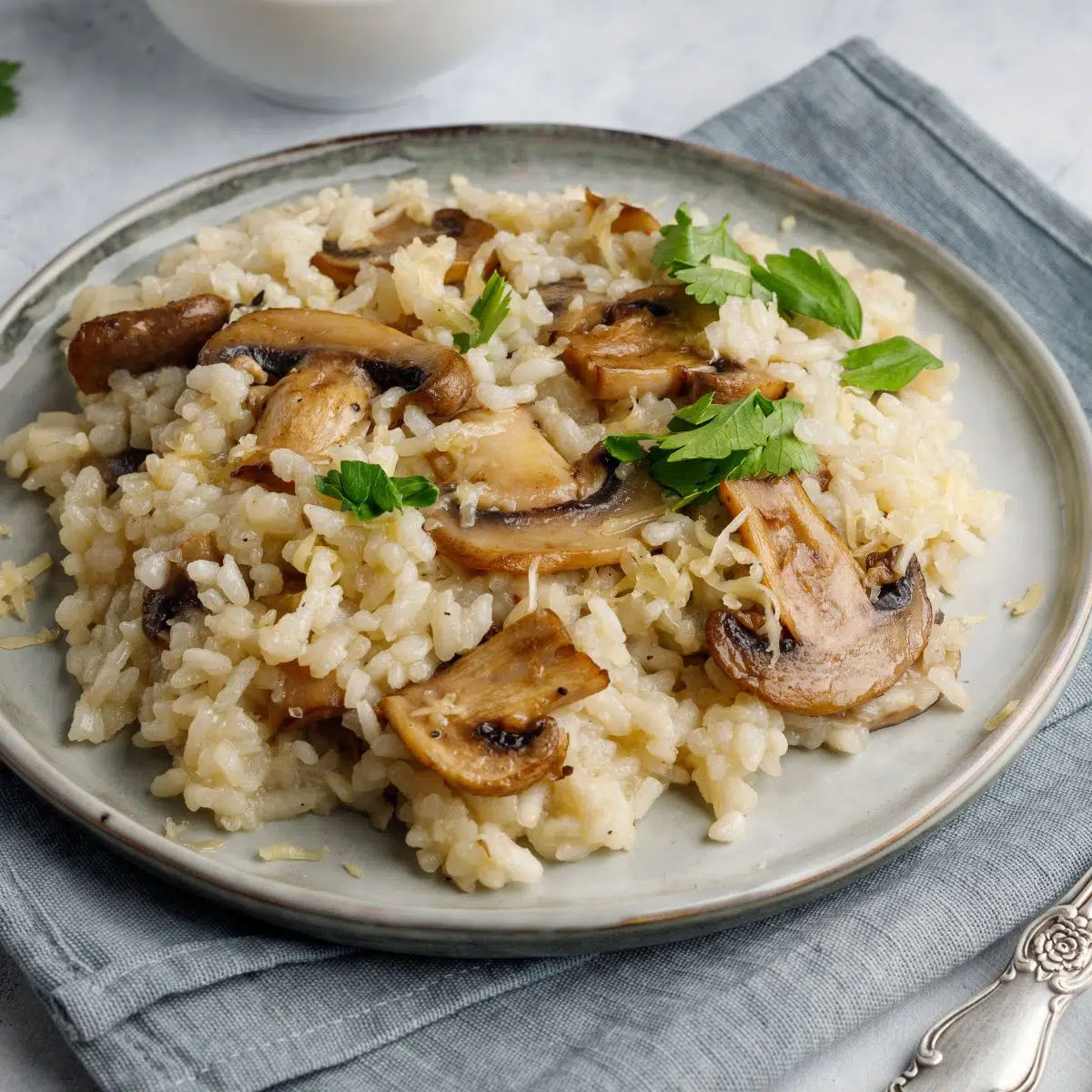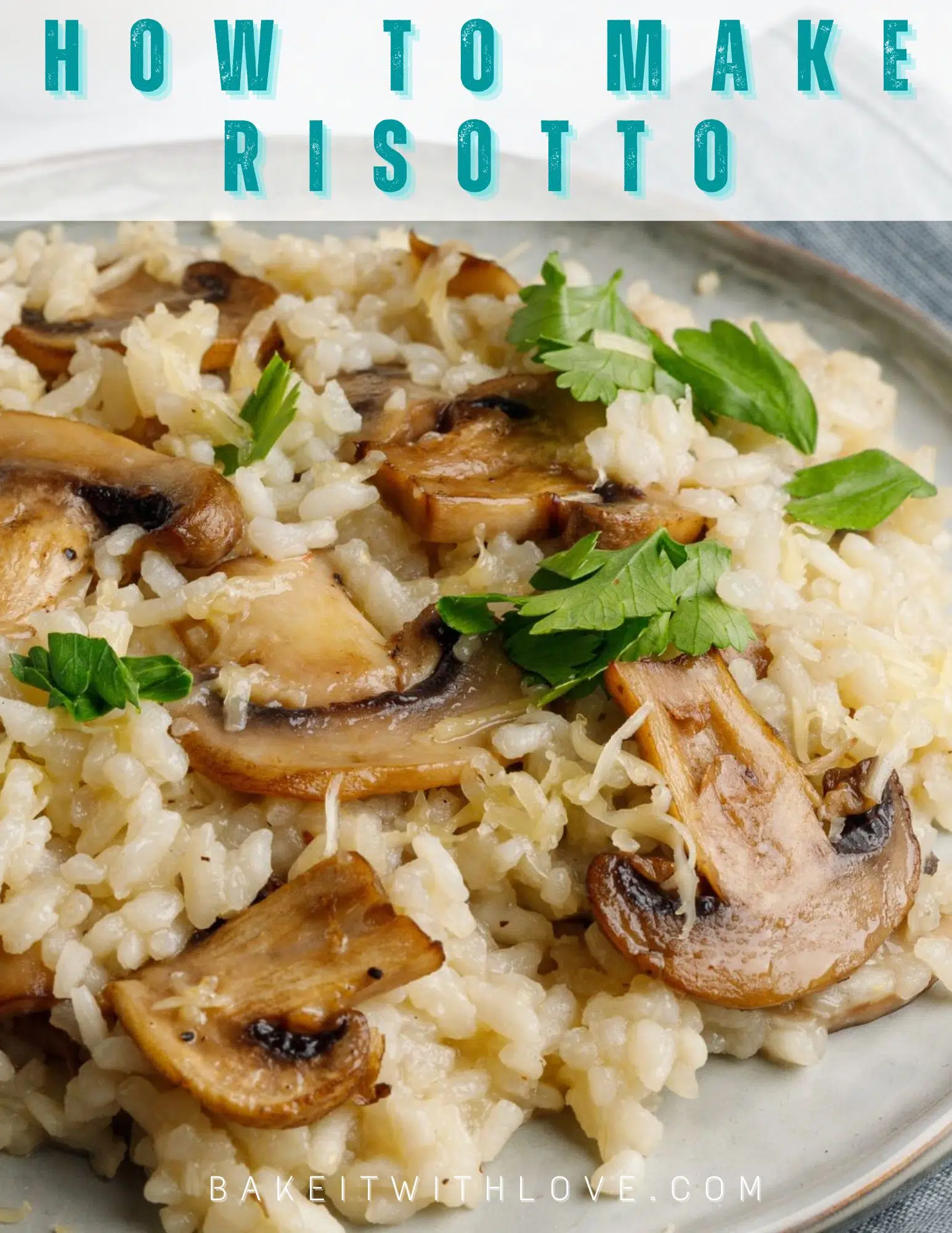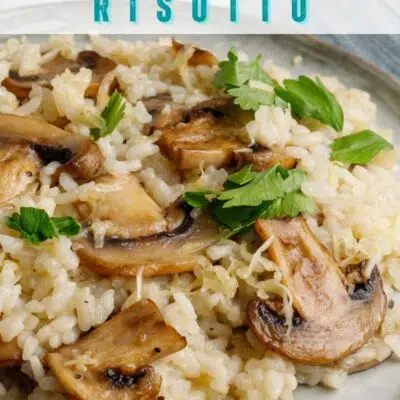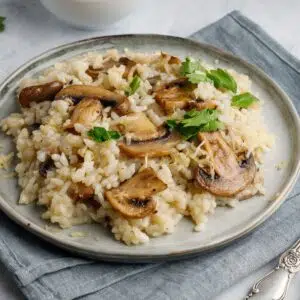Here's how to cook risotto so that you make a perfectly creamy, flavorful, and delicious meal every single time! This in-depth guide will answer any question you may have while making this popular dish! From rice options to broth choices, I will show you my favorite risotto cooking tips & tricks!
Guide To Cooking Risotto
Risotto is commonly hyped up as a dish that is difficult to make. Well, I'm here to tell you that that is not true! Sure, there is a technique to making it, but it is certainly not hard to do.
This ultimate guide to cooking risotto will show you exactly what to do to make any type of risotto perfectly! Plus, you'll realize how simple it is to prepare so that you'll be making it all the time!

Jump to:
- Guide To Cooking Risotto
- What Is Risotto
- What Rice Varieties Can Be Used For Risotto
- Should I Rinse Arborio Rice
- How Much Broth Do I Use For Arborio Rice
- Do I Need To Use Warm Broth For Risotto
- What Size Pan Should I Use To Make Risotto
- What Temperature Should I Cook Risotto
- How Often Should I Stir Risotto
- When Is Risotto Done
- My Favorite Risotto Recipes
- Serving Suggestions & Tips
- ❓ Recipe FAQs
- 📖 Helpful Cooking Guides
- 📖 Recipe Card
- 💬 Comments & Reviews
What Is Risotto
Risotto is a classic Italian comfort food from Northern Italy. Risotto recipes typically include the core ingredients of rice, onion, white wine, broth, butter, and Parmesan cheese.
Making rice in this form is called the risotto method. Rather than adding rice to boiling water, the rice is cooked slowly by adding small quantities of broth to the cooking rice. Cooking one of the risotto rice varieties in this method allows the grains to bump together while cooking and release the starch content contained in the rice grains.
The results are a super creamy rice dish that is rich and flavorful! Risotto is perfect on its own as a rice side dish, or with additions to make it a fabulous main dish for dinners.
This method of cooking rice is one of the most common ways to cook rice in Italy, yet it is a specialty dish served as an appetizer or entree at gourmet restaurants here in the United States. In recent years, risotto has skyrocketed in popularity due to reality television and celebrity chefs like Gordon Ramsay!
What Rice Varieties Can Be Used For Risotto
The type of rice you choose really does matter when making risotto! I enjoy using Arborio rice, but there are some other options you can choose from.
For a thorough breakdown, check out my post which is all about the best types of rice for risotto!
Should I Rinse Arborio Rice
No, there is no need to rinse your Arborio rice before making a risotto. None of the risotto rice (Arborio, Carnaroli, Vialone, Nano, or Baldo) should be rinsed before cooking the risotto.
Rinsing will remove the starch that is needed to make a creamy risotto (or rice pudding) and should be reserved for dishes where distinct and separate grains are desired.
It is a theory that rinsing your risotto rice with the broth you intend to use for cooking will retain the starch in the broth. This allows for better toasting of the rice kernels while not rinsing away the starch needed to make the dish come together correctly. *I have not personally tried this method, so cannot speak to any direct recipe testing results.
How Much Broth Do I Use For Arborio Rice
For 1 cup of Arborio rice, you will need to have 4 cups of broth available. You may not use all of it, or you may need just a bit more.
When making risotto, I usually heat all 4 cups of broth that I know my recipe will use plus I keep some extra broth on hand. That way, if I need a bit more broth I can easily microwave the last bit and add it to the risotto.
Do I Need To Use Warm Broth For Risotto
Yes, and this is very important to successfully cook brilliantly perfect risotto in just 20 minutes! The heated broth works best for allowing the risotto rice to absorb the liquid and continue cooking at the same consistent temperature.
Adding broth that is room temperature or straight-out-of-the-refrigerator cold to cooking risotto drops the temperature of the risotto and reduces your heat. Even if the cooler broth only affects the risotto kernels that it initially comes in contact with, you will have an uneven cook on your rice and a soupy risotto with some rice cooked more than others.
Warming your broth to a low simmer ensures that you consistently get quality results every time you make your risotto!
If time is an issue, try microwaving the broth. Heat for 2 minutes initially and warm as needed before adding to your skillet.
What Size Pan Should I Use To Make Risotto
You should use a skillet or frying pan large enough to cook your risotto in an even single layer. The rice needs to be in contact with heat to cook best.
Too much rice or too little rice and the rice won't be able to simmer correctly. Part of the risotto method is the slow simmer, which allows the grains to 'bump' against each other and release the starches that make the risotto so creamy and delicious.
What Temperature Should I Cook Risotto
Your risotto should be at a medium simmer when cooking. Start with a medium temperature and adjust slightly up or down to maintain your desired simmer.
It is desirable to slowly cook your risotto, this is a key part of the risotto method. However, if your risotto is cooked at too low of a temperature the grains can't bump together and release the starches.
If the temperature is too high while cooking, you lose the slow cooking that benefits the risotto method the most. A gentle, consistent bubble is what you are looking for when cooking risotto.
How Often Should I Stir Risotto
While you do want to stir occasionally (every 30 seconds-ish) that timing does not need to be perfect. You will get a feel for making risotto, and realize that the rice grains are moving while simmering.
Stirring too frequently is a sure way to ruin the texture of your risotto!
When Is Risotto Done
Start checking after about 15 minutes of cooking your risotto. Depending on the variety of rice used, the risotto should be done between 17 - 20 minutes of cooking.
Risotto is done when the rice is cooked but retains a bit of firmness (al denté texture) to the inner core. Your risotto rice kernels should never be mushy!
Also, your liquids should be absorbed into the rice enough that the risotto has a creamy texture. Risotto should not have either a glue-like or runny consistency on your plate when served.

My Favorite Risotto Recipes
Now that you know how to make the perfect bowl of risotto, what kind are you going to make first? Leave a comment down below and let me know!
Serving Suggestions & Tips
- Serve your cooked risotto in a warmed dish or bowl! The creaminess of risotto is the result of amylopectin and amylose (starch). This starch-based sauce will cool and thicken quickly, changing the risotto consistency for the worse.
- Stir in roasted, steamed, or sauteed vegetables at the last minute of cooking to vary your risotto side dishes.
- Use a matching broth or stock depending on what your risotto will be served with. For example, use vegetable stock for a mushroom or butternut squash risotto OR use seafood stock if serving with scallops or shrimp.
❓ Recipe FAQs
Risotto is unique in that the rice cooks down to form its own creamy sauce. The specific grain varieties and the risotto method of cooking combine to make this dish a true treat to enjoy!
Risotto cook times will vary slightly depending on the temperature it was cooked at, and the rice variety. Overall though, the risotto should be done cooking between 17 - 20 minutes.
Yes! Risotto can be made without the wine, just start adding your broth ( or even water ) and cook as directed.

📖 Helpful Cooking Guides
- How To Make Meatloaf - Check out this guide to making the best meatloaf possible!
- How Long Can You Keep Prime Rib In The Freezer - This article will walk you through how long you can safely keep your prime rib frozen.
- Types of German Sausage - Find out all about the different varieties of German sausages!
- How To Freeze & Reheat Rice - This guide will show you the best methods for freezing and reheating rice so that it is just as delicious as when you first made it!
- Grill Temperature Guide - This helpful walkthrough will break down exactly what different grill temperatures mean.
- Fresh To Dry Herb Conversion - These conversions will show you exactly how many herbs you need for any recipe!
Do you love a recipe you tried? Please leave a 5-star 🌟rating in the recipe card below and/or a review in the comments section further down the page.
Stay in touch with me through social media @ Pinterest, Facebook, Instagram, or Twitter! Subscribe to the newsletter today (no spam, I promise)! Don't forget to tag me when you try one of my recipes!
📖 Recipe Card
How To Cook Risotto: Parmesan Risotto (The Ultimate Guide!)
Ingredients
- 4 cups chicken broth (heated to a low simmer in a saucepan)
- 1 tablespoon olive oil (extra virgin)
- 1 cup Arborio rice
- ¼ cup shallots (or white onion - finely minced)
- 2 cloves garlic (finely minced)
- ¼ cup dry white wine (up to ⅓ cup - I used Pinot Grigio)
- 2 tablespoon butter (salted, in 1 tablespoon pats)
- 2 tablespoon Parmigiano Reggiano cheese (plus more for garnish when served, if desired)
- ¼ teaspoon each, salt & pepper (to taste)
(Note: 2x or 3x only changes the ingredient list)
Instructions
- Bring a large skillet or frying pan to medium heat. Add olive oil, then add garlic and shallots. Cook until softened, about 1-2 minutes.
- Add your Arborio rice and cook the kernels, stirring occasionally, for about 1-2 minutes.
- Add the dry white wine and cook for one minute, stirring frequently.
- Add one cup of the broth and stir occasionally while the rice cooks and absorbs the liquid. Ladle in additional amounts initially in approximately ½ cup portions. Allow the rice to absorb the liquid as added.
- When your rice has cooked for about 15 minutes, the rice will slow down on absorbing the liquid when added. Use smaller ¼ cup portions as you near the end of the cooking process.
- You are looking for an al dente texture to your rice, and I start checking for this at the 15 - 16 minute mark. Test an individual rice grain for the soft texture that still retains a semi-firm core to the grain.
- Once your rice has reached an al dente texture, remove the risotto from the heat and add the butter and Parmigiano Reggiano. Stir to combine and serve on warmed plates with additional freshly grated Parmigiano Reggiano cheese, if desired.



Comments
No Comments